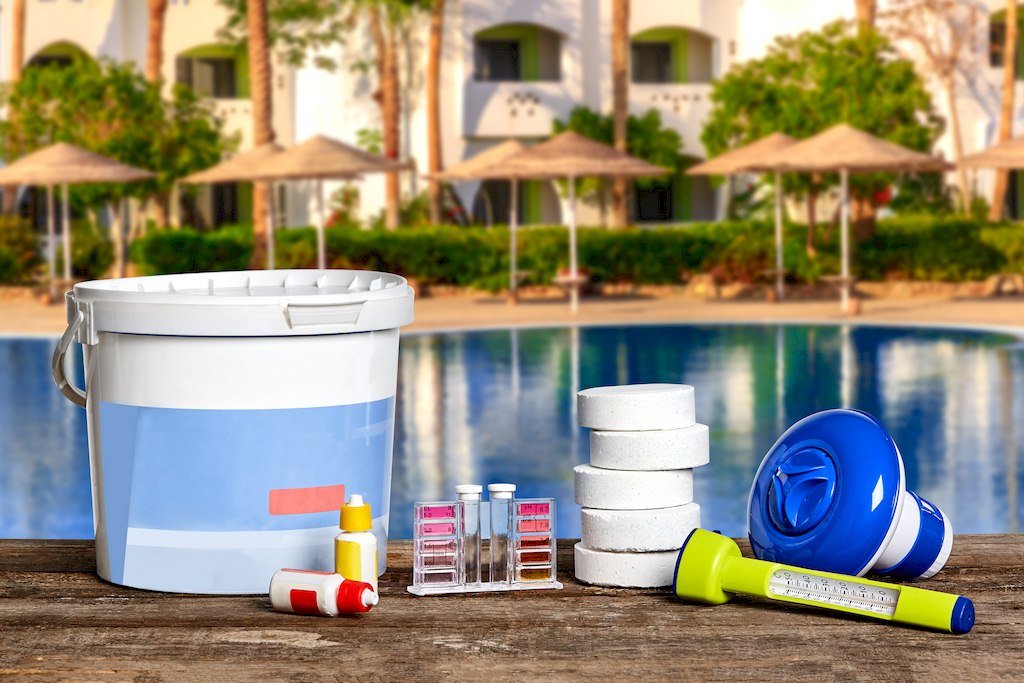Table of Contents Show
Spending summer months by your pool may seem like an ideal solution to these lockdown woes. But, before you dive in, make sure to check if the pool is clean and safe.
A pool with floating dry leaves or algae can obviously lead to skin irritations and other issues. That’s why it’s important to maintain the cleanliness of your swimming pool at all times.

Here are some effective ways to properly maintain your swimming pool:
Ensure Proper Water Circulation
First and foremost, good water circulation is the most important step towards having a well-maintained pool. Stagnant water in your pool may lead to bacteria growth and algae, which would make the water look cloudy.
Good circulation will improve the pool’s water quality by filtering it.
To ensure pool cleanliness at all times, experts advise on keeping the water filter and pump on the whole day, if that doesn’t sound feasible to you, go for 10 to 12 hours of water circulation.
Sanitize the Pool
The easiest way to sanitize a pool is by using chemicals, like chlorine. But, often, these chemicals spoil the pH levels of your pool and lead to skin irritations or allergies. Instead, opt for a mineral sanitizer.
It’s a natural blend of salts and nourishing minerals, like magnesium, from the dead sea. Mineral swim pool sanitizer balances the pH levels and improves water quality, which can be both relaxing and rejuvenating.
Use the Correct Filter
There are three types of filters used for a swimming pool: sand filters, diatomaceous earth (DE) filters, or cartridge filters.
Sand filters work better when they are slightly dirty; it’s best to clean them once every season and replace them every five years.
Sand filters are cleaned by backwashing the filter. DE filters, on the one hand, provide the best filtration and don’t need cleaning too often.
A DE filter can be cleaned once every season using a filter cleaner.
Cartridge filters can remove more dirt than sand filters and don’t need backwashing. When cleaning them, you can simply remove the cartridge and, then, wash them.
Backwash the Filter
The process of water circulation is incomplete without backwashing your filter. Backwashing refers to the process of cleaning the filter by reversing the flow of water through the filter.
In doing so, the accumulated debris and other contaminants are removed from the pool. You know it’s time to backwash your filter once the water in your pool turns cloudy.
Skim Regularly
To ensure that your pool remains sparkling clean, skimming the surface of your pool daily to remove dry leaves, twigs, or insects is necessary.
Use a long skimmer so that you can clean up the dry leaves and debris easily. Try to remove the debris on the water surface before they settle at the bottom of the pool and clog the filtration system.
If you have a skimmer installed in your pool, clean the skimmer basket regularly.
Clean It Inside Out
To keep bacterial contamination at bay, clean the inside walls and surface of your pool regularly. Use a good brush to scrub the tiles and a pool vacuum to keep the walls sparkling.
Make sure you vacuum the tough corners where algae is likely to grow. You could choose a robotic vacuum that is energy efficient or a suction vacuum, which is more affordable.
Check the Water Level
The water level in your pool should be just right. If it’s too low, it can lead to a burnt pump, and if it’s too high, the skimmer door will not work properly.
Conduct Regular Water Testing
To ensure the pH balance of your pool water, use a water testing kit. Ideally, the pH level of your pool should be 7.2 and 7.6.
Use Clarifiers and Metal Control Products
Regularly use a dose of algae preventers to stop the growth of algae. Using clarifiers helps keep the water clean and ensures good water quality.
How Often Do You Need to Clean the Pool?
Yes, you have to clean the filter and sanitize the pool water. But, how often is it needed? Here’s what you need to know in this regard:
Two to three times a week:
- Skim the pool surface
- Test the pH level of the water
Weekly:
- Clean the pool surface and walls thoroughly using a brush and pool vacuum
- Add a dose of algae preventers and clarifiers
Every season:
- Clean your filter
Conclusion
Regular swimming pool maintenance is a must. Daily water circulation is one of the easiest ways to keep the pool clean.
While sanitizing the pool and cleaning the filter should be done occasionally, skimming the pool surface to remove debris on a daily basis can save you from bacterial or algae issues later.
All it really takes is a few good cleaning practices done on a regular basis to ensure good pool maintenance.










